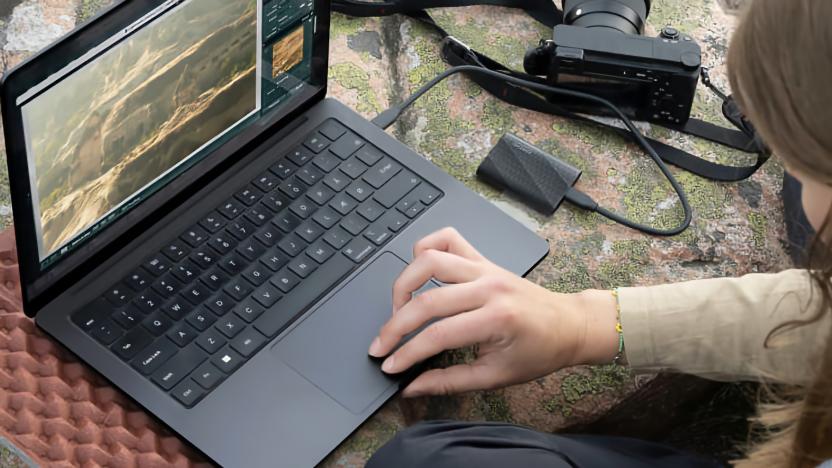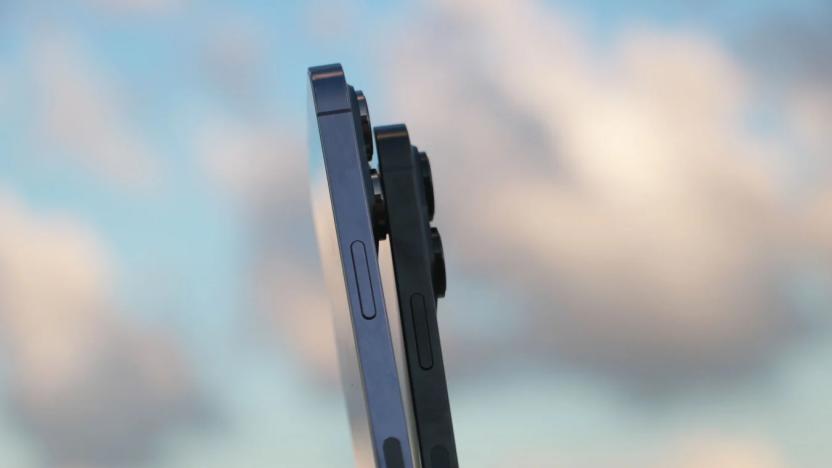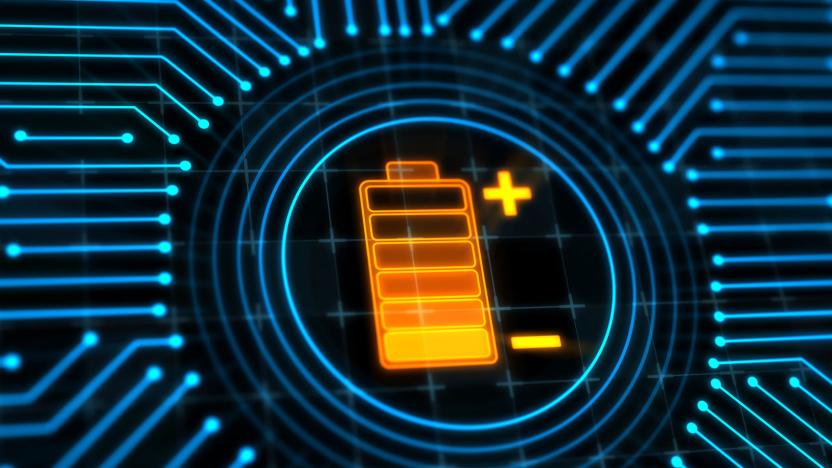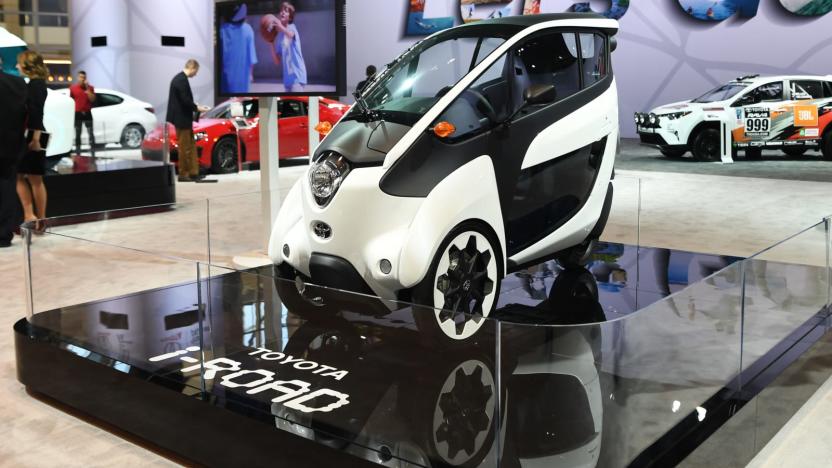solid state
Latest

Samsung’s new T9 Portable SSD is twice as fast as the T7
Samsung’s new portable solid-state drive supports up to 2,000 MB/s sequential read and write speeds. It ships in 1TB, 2TB and 4TB storage tiers.

The iPhone 15 Pro may feature haptic solid-state volume and power buttons
The next-gen iPhone 15 Pro models may swap its physical volume and power buttons for solid state versions that use haptic feedback.

Magnesium batteries could be safer and more efficient than lithium
It's still early days for the promise of safer, energy-dense solid-state rechargeable batteries. However, a team of scientists at the Joint Center for Energy Storage Research have just discovered a fast magnesium-ion solid-state conductor that will go a long way towards making non-flammable batteries with more capacity.

Toyota’s future EV battery tech could enable much longer trips
The switchover to an electric vehicle (EV) future is bound to happen, with increased sales and companies like Volvo committing to hybrid models in the next couple of years. One of the things still holding back widespread adoption of the technology, however, is the low range the current crop of EV batteries represent. We're not going to put all of our hopes into cars that can only travel so far, especially as the infrastructure to recharge such vehicles is thin on the ground. Toyota is looking to change that, however, with a new solid electrolyte battery technology that would make for smaller, lighter lithium-ion batteries, which could then combine into higher-range charges for electric cars. Toyota told The Wall Street Journal that the batteries are in "production engineering" now, and that we might be able to buy cars with the new batteries by the early 2020s.

Dyson's new battery tech promises longer-lasting electronics
Battery research that tantalizes and then goes bust has soured our dreams of longer-lasting smartphones and EVs. But do you know who hasn't given up hope? Sir James freaking Dyson, that's who. His company just invested $15 million in Sakti3, one of the most promising battery technology companies out there. The startup has created a cell with no dangerous, flammable liquid electrolytes, using the same thin-film tech used to make LCD displays and solar cells. Better still, it claims the batteries have achieved an energy density of 1,143 watt-hours per liter, easily doubling the best lithium-ion batteries on the market.

Samsung shrinks its 1TB EVO SSD, claims industry first
It's pretty much common knowledge that upgrading to a solid-state drive is one of the easiest ways to give an aging machine a shot in the arm, but not everyone considers drive size. The average SSD fits in your standard 2.5-inch drive bay, but Ultrabooks and other thin devices lean on a smaller 1.8-inch mSATA standard -- the problem is, these smaller drives don't always hold as much as their big brothers. Samsung hopes to change that: Its latest 840 EVO SSD claims to be the industry's first 1TB mini-Serial ATA solid state drive. The new SSD fits in to the smaller compact mSATA form factor, but none of its predecessor's core states seem to have changed. The new EVO still promises to read at 540 MB/s and write almost as fast: 520 MB/s. Certainly quick enough to give your old notebook a leg up. Sammy hasn't released prices just yet (though we're betting it won't be cheap), but says the new little big drives should be available sometime later this month. Don't need a full terabyte? No worries: The 840 EVO mSATA will be available in 120, 250 and 500GB volumes as well.

US Navy to deploy ship-mounted laser in 2014, blasts drones in the meantime (video)
Lasers have been flaunted by the US Navy before, but now it's announced that 2014 will see the very first solid-state laser deployed aboard a ship, two years ahead of schedule. The USS Ponce, a vessel used as an amphibious transport dock stationed in the Persian Gulf, will get the honor of hosting the prototype Laser Weapon System (LaWS). Not only can the hardware set boats and airborne drones ablaze, but it can also emit a burst to "dazzle" an opponent's sensors without inflicting physical harm. Sure, it cost roughly $32 million to construct, but the price is expected to fall when it hits wider production, and Chief of Naval Research Rear Admiral Matthew Klunder estimates that it each shot rings up at under $1. It may not be the missile-obliterating free-electron laser that the Navy's been lusting for, but we're sure it doesn't matter much to drones at the end of the beam. Hit the jump to for a video of the contraption in action.

Modbook Pro to launch with SSD storage, up for pre-order October 3rd
It wasn't all that long ago that Modbook Inc's CEO, Andreas Haas, made the mac-in-tablet Modbook Pro official, now we're learning that the super-slate will launch with high performance SSD storage. So, as you wield your MacBook Pro come tablet, you'll be free from spinning disks. Great, but what impact will this have on capacity? Well, according to the firm, storage will start at 64GB as standard, with upgrades possible all the way up to a, not-unreasonable, 480GB. Pre-orders go live on October 3rd, along with the all important reveal on price. Regardless of cost, if that void between the iPad and full-fat Windows 8 slates had been irking you, here's your answer.

SanDisk announces 32GB ReadyCache for Windows: $55 at Amazon, keep your existing HDD
SanDisk has built itself a decent reputation in the SSD game, and a cheap cache-only drive is a logical addition to its line. Unlike regular SSD or hybrid upgrades, you don't have to transfer your system to the new drive -- the 2.5-inch, 32GB add-on simply hooks up to a spare SATA III port alongside your spinning storage and then you run SanDisk's ExpressCache software to do the rest. The program, which is currently Windows 7-only, monitors which files you access most frequently and then automatically caches them on the SSD, promising up to 12x faster application launches and also faster boot times compared to your HDD working on its lonesome. Importantly, the ReadyCache works with multiple hard drives too, rather than just boosting your primary drive -- a feature that SanDisk claims gives it a one-up over most other caching solutions. The list price is $100 but Amazon has it up right now for $55.

SSDs kick up performance for developers and users alike
I'm a developer. One of the things we devs do to pass the time is complain about how long it takes to compile and brag about the power of our development systems. Hot-rodding your system isn't just limited to development, though. There are lots of people out there who sit and wait as their systems limp along from the start up chime to the login screen. You probably already know that adding RAM generally makes your Mac more responsive, but do you know how much of a boost you might get from a solid-state drive (SSD) versus a conventional hard drive? TUAW friend Maurice Sharp decided to test it out. He got down and dirty with his Macs and timed how long it look for HDD and SDD based systems to perform various operations. Here are the results he achieved, comparing solid state response times to hard drive response times. 1 MacBook Pro 2.3GHz i7, 16GB RAM 2 Project build folders were cleaned before each compile 3 Build phase only. 2000 C++ and 400 Objective-C files 4 Mac Mini 2GHz i7, 8GB RAM 5 MacBook Pro 2.4GHz i7, 8GB RAM 6 MacBook Air 1.8GHz i7, 4GB RAM 7 21296 lines of code Look at the typical differences he experienced. Although this chart is focused on code-based tasks, his day-to-day startup times also massively decreased. Sharp writes, "There is one caveat. To switch over to SSD, you have to clone your current hard drive to the new drive. For a 500GB drive, this took about 4.5 hours (thanks Carbon Copy Cloner). Plus another 15 minutes to install the drive. Of course this can be done out of hours, or by an IT department if you have one. [But] now you can generate the numbers you need to show your boss, or even yourself, why an SSD drive is a good investment." Don't expect miracles, however. Another TUAW dev buddy Matthias Ringwald reports, "I replaced the HD in a 2009 Mac mini in 2010 with an Intel 160 GB SSD. While it got more snappy/faster boot times etc, the compile time for our Dybuster Dyslexia C++/Qt project decreased only from 7 minutes to 6 minutes." That said, a 17% decrease in compile time is nothing to sneer at. What's behind the difference? Sharp proposes "There are obvious things like the speed of accessing information on a the drive comparing a rotational system where the sector may or may not be at the head, and may or may not be cached, versus no reliance on mechanical rotation. But there are other things that may account for the lack of gain that Matthias was seeing. That is related to using the disk for virtual memory paging. "As you probably know, the OS uses part of the disk to swap out parts of RAM that are not in use, especially when the memory needed is greater than the physical RAM. If there is a lot of paging, that will suck performance, even with an SSD, as the system dedicates cycles to swapping RAM contents on and off disk. This is why I boosted my RAM first and got a sense of how that worked. Using something like iStat menus, you can see how much memory is being used and how it is allocated (as well as the processes that are hogging it!)" If you've gone to an SSD-equipped system on your development machine, has it made a dramatic difference? Or have the improvements been more subtle? Join in the conversation below.

Crucial ships mSATA-based m4 SSD upgrade, your Ultrabook never felt better
Crucial has already managed to stuff its m4 SSD into Ultrabook sizes, but the 7mm thick design may still be too portly for the thinner laptops in the pack. With that in mind, the flash memory guru has just started shipping the m4 mSATA, a barebones card that sits cozily next to the motherboard either as a cache for a rotating disk or as a main drive. It's still as speedy as many of its bigger cousins, with read speeds of up to 500MB/s per second. We suspect most buyers will be lured in by the low prices: at just $53 for a cache-friendly 32GB SSD and no more than $226 for a 256GB example, it's entirely feasible to give that spinning-drive Ultrabook a shot in the arm.

Corsair Force GT SSDs put through their paces, have graphs to prove it
Instead of singling out one of Corsair's latest SandForce-equipped SSDs, the folks at StorageReview sussed out performance differences by putting each drive through the wringer. Though read / write specs are relatively uniform across the line, barring some slight dips in speed, they dug up a few juicy morsels of info that could benefit both frugal and performance-minded shoppers. In a read intensive gaming test, the 60GB entry drive performed similarly to the 480GB behemoth. Another notable result was a 60% jump in throughput between the 120GB and 180GB models. Keen on eking out the most performance-bang for your buck? Hop over to the source for the full skinny and a bevy of charts.

OWC's Mercury Accelsior PCIe SSD is Mac bootable, strictly neutral
If you've ever tried to jam a regular SSD into your Mac, then you'll know that many off-the-shelf drives feel like they're tailored and tested for, ahem, someone else. Not so with OWC's Mercury Accelsior, which claims to be the only Mac bootable and Mac supported PCIe SSD on the market. Regardless of which platform you use it with, however, the dual-SandForce card promises some neat tricks with its 24nm Toshiba Toggle NAND. Sequential read and write speeds are around 50 percent higher than what you'd get from a regular SATA III drive, with the cheapest 120GB model ($360) offering 758MB/s reads and 743MB/s writes. Random performance is notched up too, with around 100K IOPS in both directions. The 960GB version costs a coldly precise $2,096, but still -- a potential side order for when the Mac Pro line finally gets another refresh?

OCZ says its Indilinx controller is actually built by Marvell, but has custom firmware
OCZ received stacks of praise following its brave switch to in-house Indilinx-branded controllers, which have delivered solid performance in both the Octane and Vertex 4 SSDs. However, the company has now confirmed to AnandTech that its Indilinx Everest 1 and 2 controllers are actually still based on Marvell products, with a little overclocking on the side, and it hasn't yet implemented its own hardware. That would explain why the latest SSDs are so closely on a par with other Marvell-powered drives, like the Crucial's m4 and Intel's 520. But if it sounds like the brightest kid in the class just admitted to copying some other student's homework, then we should probably all chill out: after all, OCZ never made any precise claims about Everest's provenance in the first place. Besides, one of the most important aspects of a solid state drive is its firmware and OCZ insists that's totally home-cooked. The news here is that we still haven't seen what OCZ is fully capable of following its Indilinx acquisition.

Intel 313 SSDs bring improved caching to ultrabooks, desktops, life in general
Just like Intel's older 311 batch of small cache SSDs, the new 313 series is designed to sit alongside a traditional spinning HDD in order provide a tasty blend of speed and capacity. These newer drives are still SATA II, so there's no 6Gbps action here, but they use superior 25nm SLC flash, offer faster speeds for the same price (starting at $120 for 20GB) and are explicitly approved for use in the coming wave of Ultrabooks -- so don't be surprised if that's where you meet 'em next.

SanDisk Extreme SSD has 'mighty' mix of performance and support
SanDisk's new Extreme SSD sounded nice enough when it launched recently, but we weren't expecting anything too crazy -- just another 6Gbps SandForce-based drive that would compete on $-per-GB more than performance. As it turns out, that doesn't do it justice. StorageReview has shown that the unit actually beats the Intel 520 in some key real-world tests and delivers a "chart-topping" 4K random write speed of 88,324 IOPS. With the bonus of the low price-point -- starting at $190 for 120GB -- and the level of support from SanDisk, the Extreme SSD can now boast an Editor's Choice trophy. Click the source link for the full report.

Plextor announces M3 Pro SSD with 24nm flash and 7mm form factor
Bored by Plextor's safe and steady M3S? Then ponder on its new performance model, the 2.5-inch, SATAIII-sporting M3 Pro. It notches up random read/write speeds by around seven percent to 75,000/69,000 IOPs, while sequential read/writes have also had a marginal bump to 540MB/s and 450MB/s. It's not yet clear how much the new drives will cost when they reach stores in 128GB, 256GB and 512GB varieties next month, but the use of 24nm toggle flash -- which squeezes more storage onto less silicon -- should help to keep pricing relatively sane. Oh, and the 7mm height also means that the M3 Pro will slide happily into the compressed bowels of your Ultrabook -- unless that slot has already been reserved for a Crucial. Read on for the press release.

Crucial outs Adrenalin Solid State Cache Solution, less long-winded m4 SSDs
Until the cost of flash storage comes down to the same plane of existence as most human wallets, hybrid solutions -- which pair an HDD with an SSD cache -- remain a smart way forward. OCZ scored some attention with its Synapse products, so now Crucial has to wave its arms in our faces and point to its own offering: the Adrenalin Solid State Cache Solution, which pairs a 50GB m4 SSD with proprietary caching software, and which will be out sometime this quarter for an undisclosed but surely rivalrous price. In the meantime, a fresh range of pure-breed m4 drives is already available, looking much like their predecessors but now whittled down to a mere 7mm in thickness so they can be squeezed into ever-narrower crevices. Pricing starts at $119 for 64GB and tops out at $795 for 512GB -- like we said, not your average plane of existence.

OCZ Octane SSD benchmarked, new Indilinx controller holds its ground
Maybe it's just interference from our seasonal goggles, but isn't there something quite cheery about SSD reviews? In the case of OCZ's Octane drive, our good spirits derive from the sturdy performance of its freshly-conceived Indilinx Everest controller, which ought to keep big players like SandForce and Samsung on their toes. HotHardware just reviewed the $369 $879 512GB variant and found that it delivered fast boot-up times, strong read speeds and writes that were just shy of enthusiast-class drives. Follow the source link for the full and possibly festive benchmarks. Update: Sorry about the optimistic price error. Guess we got carried away with all the holiday discounts. As many of y'all spotted, it's the 256GB version that goes for $369. Update: We just added links to reviews from AnandTech and Storage Review, which both arrived at similarly positive conclusions.

TRIM or RAID 0? SSD owners will no longer have to choose
Owners of multiple SSDs will be familiar with this dilemma: do you opt for RAID 0 to put all those precious GBs to use, or do you go for AHCI mode in order to gain TRIM support and maintain performance over time? Well, the next release of Intel's RST should support TRIM for RAID 0, so switching to solid state storage will become an even smarter decision than it is right now. [Thanks, Brian]







